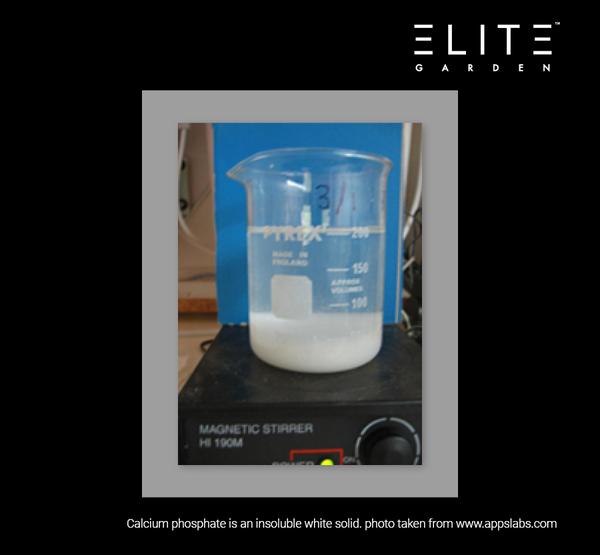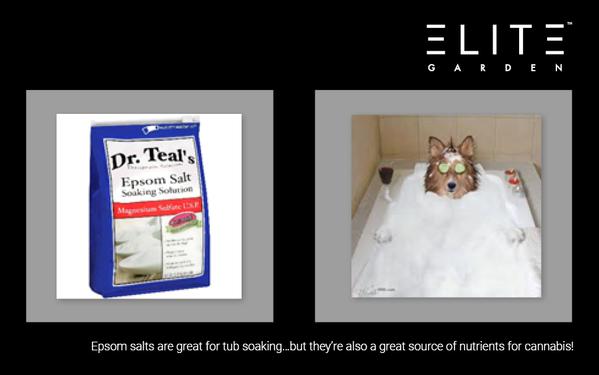Dr. NPK of Elite Garden Wholesale goes over a few secondary macronutrients and their importance in cultivation.

The following is an article produced by a contributing author. Growers Network does not endorse nor evaluate the claims of our contributors, nor do they influence our editorial process. We thank our contributors for their time and effort so we can continue our exclusive Growers Spotlight service.
Disclaimer
This article has been republished with permission from Elite Garden Wholesale. The original article can be found here.
Hi everybody! Welcome to this installment of Dr. NPK! This post is dedicated to the unsung heroes: the secondary elements! If you’re a football fan like me, this is the “O-Line” tribute for cannabis science.
A lot of focus is placed on the primary macronutrients (nitrogen, phosphorous, and potassium, a.k.a. N-P-K), but these elements can’t do their job without the right supporting staff. I’m talking about the secondary macronutrients:
- Calcium (Ca)
- Magnesium (Mg)
- Sulfur (S)
- Iron (Fe)
I want to make one important distinction: many people categorize iron as a micronutrient and thus would not be consider it a secondary macronutrient; I make a personal choice to incorporate iron into my list of secondary macronutrients for two reasons:
- Iron is typically used at a higher treat rate than many other micronutrients
- Iron deficiencies often present the same symptoms as those of secondary macronutrient deficiencies.
Calcium: Builds Strong Bones and Strong… Buds?
By a mile, calcium is the most commonly discussed secondary nutrient. Calcium plays an important role in any plant, not just cannabis. When you think of calcium, you should think of the cell wall. Calcium ions (Technically Ca2+ if you really want to get into it) helps plants develop their cell walls. Cell walls prevent diseases as well as to ensure proper and even growth. Calcium deficiencies tend to manifest in the growth of younger leaves; calcium ions are immobile in the plant, so a deficiency in calcium will affect the younger leaves.
Water-soluble calcium is usually found in the highest concentrations in fertilizer formulations that include the secondaries. Calcium is typically listed as “water-soluble calcium” on the back of fertilizer bottles; for some organic products, it is a suspension in water what is usually derived from dolomite, a calcium/magnesium carbonate. The most commonly used source for fully water-soluble formulas is calcium nitrate. Elite CalMag and Elite Base Nutrient A both contain high concentrations of fully water-soluble calcium.
One final note: Have you ever added your total nutrient regiment into you tank and notice some white solid show up out of nowhere, quickly? Don’t worry, that’s likely not something biological (don’t you wish that was the news you always got?), it’s a sign of nutrient lockout. In all likelihood, you are forming one of a few insoluble salts: calcium phosphate, calcium sulfate, or maybe even calcium silicate. These salts are practically insoluble, but also harmless to the plant.

Magnesium: Keepin’ it Green
Following behind calcium on the secondary nutrient totem pole is magnesium. Water-soluble magnesium typically runs in smaller concentrations (Approximately 1-3%). Sources of magnesium in liquid nutrients include magnesium nitrate, magnesium sulfate (commonly called Epsom salt), or magnesium acetate. Elite CalMag and Elite Base Nutrient B contain high concentrations of water soluble magnesium.
I used to work at Rite Aid when I was in high school/college. I had a rude customer ask me one time where our chlorophyll pills were. I replied that perhaps he should go outside and eat a plant. Yes, I was formally disciplined and probably should not have been so snappy (hindsight is 20/20), but I promise you that this leads me to my next point: magnesium!
Magnesium is an important element in photosynthesis. Magnesium is believed to be a key contributor in converting sunlight to actual energy within the plant, likely due to its influence on chlorophyll (Yang et al, The Crop Journal 4 2016, 83–89). Thus, insufficient magnesium means fewer chlorophyll and therefore crappier photosynthesis.
Magnesium deficiencies tend to present themselves in older leaves as magnesium is a mobile nutrient. The plant will direct what little magnesium it has to new growth, leaving older leaves magnesium deficient.

Silly Sulfur, S is for Kids
Epsom salts may be great for tub soaking… but they’re also a great source of nutrients for cannabis!
Sulfur is an interesting element. The crux of my Ph.D. is based on this element. My wife isn’t a fan: sulfur compounds usually smell of rotten eggs (or for the less mature of you, farts). Regardless of the smell, plants absolutely need sulfur. Sulfur can be provided to the plant in a variety of ways:
- Elemental sulfur (as a milky-yellow suspension)
- The sulfate (SO42-) ion (such as in magnesium sulfate) which is also the most plant-available form.
- Bisulfite/sulfite (SO32- and HSO3-, respectively) in sodium bisulfite.
Sulfur is important in plants for a variety of reasons. Although it is important in catalytic processes and chlorophyll production, one of its hallmark attributes is its role in amino acid production. Amino acids are the building blocks of proteins, and proteins play a pivotal role in the strength of your plant as well as your yields. Sulfur is also important in essential oil production. Thus, insufficient sulfur means fewer amino acids and a reduced yield and droopy plants. No one likes droopy plants!
High concentrations of water-soluble sulfur are found in Elite Base Nutrient B, via magnesium sulfate, which is the most plant-available form of sulfur available on the market. Oh yeah, and it doesn’t smell like rotten eggs, so that’s a plus.

Pumping Iron
Although needed in significantly smaller concentrations, iron is still a vital element for cannabis growth. I will go into significantly more detail about iron in a later post, so a broad overview will suffice here. Iron is an ion that can be attacked by many other ions (Editor’s Note: “Attacked” is chemistry-speak for a redox reaction); to avoid this in your reservoir, iron should be supplied in chelated form; this protects the iron ion. The most commonly supplied form of plant-available iron is iron EDTA. Iron is found in Elite Base Nutrient A and Elite CalMag.
Iron serves a variety of functions in the plant, mostly involved with chlorophyll and chloroplasts. Iron, like magnesium, plays an important role in the development of chloroplasts, which are a key component of chlorophyll (Rout, G.; Sahoo, S. Reviews in Agricultural Science 2015, 3, 1–24). This is why iron deficiencies are categorized by the browning of leaves. No iron means no chlorophyll, which means no green, therefore you make no green, in the bud sense.
Closing Thoughts
Although used in lower quantities, secondary macronutrients play a pivotal role in the plant growth. If you don’t pay attention to them, your plants will suffer. Elite Base Nutrient A and B provide all the secondary nutrients you may need. If you’re using RO water, Elite CalMag will provide the right supplement to your water to make sure you’re getting all those important secondaries!
10 Best Gift Ideas for Cannabis Connoisseurs and Growing Aficionados (2022)
December 7, 2022Developing and Optimizing a Cannabis Cultivation System
December 14, 2021Dealing with Insomnia: How Can CBD Help?
December 10, 2020Your Guide to Sleep and CBD
December 7, 2020
Do you want to receive the next Grower's Spotlight as soon as it's available? Sign up below!
Resources:
Want to get in touch with Elite Garden Wholesale? They can be reached via the following methods:
- Website: https://www.elitegardenwholesale.com/
- Email: info@elitegardenwholesale.com

Do you have any questions or comments?

About the Author
Dr. NPK has been in the chemical formulating business for over 9 years. With a Bachelors in chemistry from UCLA and a Ph.D. in chemistry from UC Irvine, he has always had a passion for chemical formulation. Over the past several years, his focus has narrowed towards the research and development of products that are optimized for cannabis. He assisted in the development of the Elite Nutrient line and takes great pride in the products he created and uses himself. He has made it his mission to cut through all the pseudoscience available on the web and to educate readers on the science behind growing top-shelf bud.